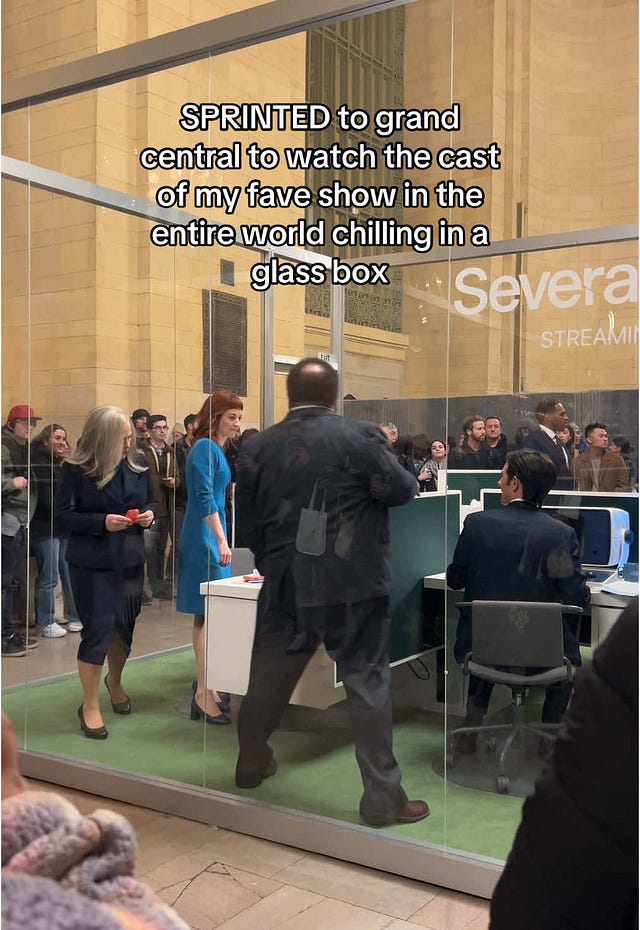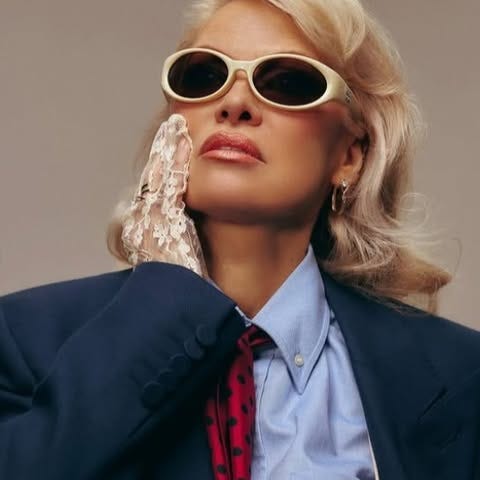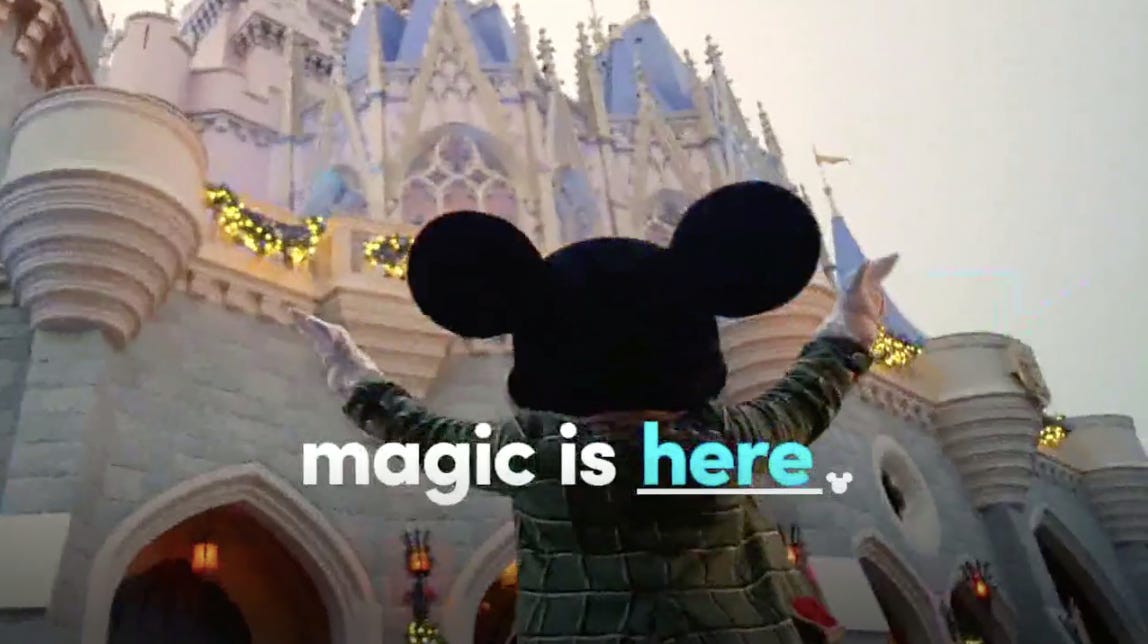Hello, my name is Tami, and I’m an addict. It’s been 5 days since my last episode of Severance.
Listen, this is the most meta form I think I’ll ever write about any big concept in. From the pop up brand building campaign in Grand Central that I covered as a part of my working life doing culture monitoring, I am now hooked on a show about surveillance and autonomy in the workplace, and how much of yourself you give over to work. It’s very woozy - much like the experience of watching Severance - so you’ll have to forgive this Stack for how deep down the rabbit hole we go.
 Tiktok failed to load.
Tiktok failed to load.Enable 3rd party cookies or use another browser
… But have you all been noticing lately just how much… well, office propaganda is everywhere all of a sudden?
I’m less interested in the aesthetics - that has already been covered beautifully by Kristen Vinakmens - and I’d highly recommend this read. There’s no denying that creative directors are really picking up what office sirens are putting down.
My feelings and observations about this are more in the cannon. Whenever something is being pushed down my throat, I can’t help but try and identify the hand that is doing the pushing. With its filter through to fashion, and its newfound coupledom with young, slim, beautiful women, I’ve had to ask myself: why is the office trying so hard to be liked?
For anyone that is a part of, or vaguely concerned with, the corporate working world, you’ll know this *office is good, hybrid is bad* narrative has been around more or less since 2022 in the mainstream, although I can find traces of it bubbling in 2021. You know, whilst the deadly global pandemic was rampaging on and threatening all of our lives when we existed within a few feet of one another for prolonged periods of time. It’s latterly one of the most banal uses for LinkedIn - a debate volleyball tossed between left-leaning and right-leaning (or, for short, those organisations that have market value tied up in their properties, and those that don’t). We’ve seen every argument for and against, ranging from the bombastic (‘remote work has caused generational loneliness and depression’) to the deeply troubling (thinly-veiled doxxing). Still, we can’t find the much-needed middle ground. The ayes stay with the ayes, the nays stay with the nays, and all the while the media continues to court big opinions from old, rich white men.
So, I did what any good brand strategist would do. I saw a problem, and I thought: ‘Yeah. I’ll have a go at that.’
Accepting what is, exploring what could be
If ‘the office’ as a concept were a person and I were their designated brand fairy, I’d be holding their hands as I said this: you need to let the past go. We’ve moved on.
Nostalgia and styling certainly go a long way to convince people there’s joy to be found in what was, but the reality is this: your category has been completely disrupted. You can either keep pouring energy, time, and money into resisting the tide, or you can take your place in a new future. This is the time to get excited! This is where innovation happens. So let’s start where any brand strategy worth its salt does - research.
Offices, you have an image problem
Not for discussion - we listen, and we don’t judge. Your customer perception data would tell you that:
Offices are seen as a physicalisation, and tool, of the patriarchy. Take any *office for entertainment* show, and you’ll see the exploitation of women’s work, their dumbing-down, minimising, and collapsing to ‘love interest’, ‘sex object’ (you deserved better, Joan), or comic relief. That hasn’t happened by accident - of course, it’s a supersized, hyper-dramatized version of reality, but it’s still based on reality. The number of female CEOs at S&P 500 companies has just overtaken the number of CEOs named John. Until you reckon with the years of misogyny associated with a traditional workspace, you leave yourself open to undermining and being pushed into obscurity. And, while we’re here? Getting women to cosplay power in fashion isn’t the way out of this. There’s something very awful and beautiful about the Pamela Anderson arc of Netflix documentary about taking control of her own image again, to ‘The Last Showgirl’, to an Elle cover dressed up as an office siren. The cycle feeds itself.
The other common thread through the office space is dystopia - listlessness, a sense of climbing to no end, a struggle against disappearance. Again, a recurring thought through Mad Men, Severance, and The Office is the search for meaning, very often teased out as a parallel to life and death. These are spaces that remind us of the passing of time, and all the places we’d rather be. The office has a choice to make - try to get people to forget that, or become self aware of it.
The industrial age is over - we’re in the age of tech feudalism, or tech-enabled passivity. Once upon a time, the office was all about productivity, clocking in and out, but is that really what we’re aiming for in the age of AI? Productivity and time taken to complete tasks has become an obsolete measure - so what are these spaces really here to do in 2025?
Know thine enemy
I am consciously trying to move away from brands having ‘enemies’ but I haven’t found a good replacement metaphor yet, so it’s staying for now. When I’m positioning a proposition, it’s always good to find the edges, the guardrails of what exists now, so we can make good choices about where we want to be in relation to that. I usually do that with competitor analysis (hence, ‘enemies’), so let’s take a look.
Seemingly, for the office, the ‘enemy’ is the more available, convenient, and comfortable alternative - the home. But what does that mean, ‘working from home’? It’s just a building in a different place, sometimes with people you love in it, sometimes with people you’d like very much to get away from. I don’t think the real enemy is the concept of home. I’d like to posit that there are a few more insidious enemies for the workplace to combat:
The commute - who would choose sitting in overcrowded, under-serviced public transport during rush hours, giving up potentially hours extra of your time before you’ve even begun your working day?
Hygiene - another byproduct of the time we’ve all lived through, but spending hours in recycled air with other peoples’ germs and differing ideas about personal care? It’s not the MOST immediately appealing.
Downtime and our perception of productivity - what do you do in an office when things aren’t coming together for you? You yap. You get bored, maybe check your phone. You become *painfully* aware of how many hours there are until your release. You think about all of the things that need attending to in your ‘real life’ - you know, the one that is waiting for you on the other side of office time. And then the anxiety creeps in: why am I here?
It seems a lot of the office’s biggest problems are wrapped into the existing blueprint we have for its brand experience. So we come to the crux: the proposition itself, and how we position it better.
Disneyland for genius
Walk with me - we’re going to talk about Disney.
Why? Because Disney as a brand has successfully commoditised something desirable (‘magic’) and physicalised it into being location-dependant (its parks). When we think about workplaces, the ask is not dissimilar: we want to make it so that genius is location-dependent, at least for some period of time.
Why ‘genius’? Well, the existential crisis we’re all having around the AI revolution is soothed by the idea that creativity and human invention can and will never be replaced. As long as that’s true, that is how we get people excited about the work that they do. Whether in collaboration, or in perfect isolation, the office proposition should be built around facilitating for that genius, in whatever form.
That facilitation part is crucial. Disney aren’t trying to say ‘we’ll turn you into a magician’. They don’t say ‘we’ll give you family’ either. But what they have honed in on is that special feeling that happens when you are making memories with people you love. That’s the ‘magic’, and that’s what they are promising you when you spend time at one of their parks. It’s an enduring appeal - the idea that we’ll be able to suspend time and bottle the feeling we find in experiencing something together (this is something I’ll write about in a future issue, I promise).
No wonder we keep coming back for more.
I’m not suggesting the workplace will ever get there. But here are some things I’d try to learn from Disney, if *the office* was my client:
Big sky - There’s a reason Disney parks happen outdoors. I think workplaces that pen us in and keep us under fluorescent lighting all day have had their time. Y’know what we haven’t tried yet? Workspaces in parks, in community gardens, in glass orbs overlooking moors in the rain. There’s nothing more inspiring than nature, and no, your plant wall doesn’t count.
Acknowledgement that your time is precious - Okay, everybody breathe. What if the goal of an office was actually to get you to leave it? And so everything in that space facilitated for you to do better work in a shorter time. What if your office reminded you to take walking breaks by prompting you on Slack to have a screen break and get outside? What if your office had ‘focus zones’ built around the Pomodoro technique, that timed out after 25 minute bursts? If Disney is built around lengthening time with family and friends, what is keeping the workplace from acknowledging how crucial that is, too?
Make the small things the big things - If there’s one thing your wristband at Disneyworld knows, it’s that a bit of cosy personalisation goes a long way. How could a workspace make you feel like you were coming home to something - from a personalized ‘hello’ as you swipe in for your working hours, to having a community movie or book library per office, complete with ratings cards, and the opportunity to leave recommendations. The brand manager that lives inside my head is dying at the thought, but what if you gave each team some spray cans and a wall to mural on, and let them have at it in their collaborative spaces?
Delight the eye - Speaking of interiors - Disney can tell you a thing or two about a cohesive property. Offices have been bland, beige, soulless spaces for too long. If people want to do their best work under a blanket, why aren’t we thinking about quilted rooms? What if you created an in-house dining area that felt more like your grandparent’s big table at Sunday dinner, or what if your workspace offered you a hotel-like spa and sauna to unwind in during work hours, and at the weekend?
I have a hunch that ending somewhere between a spa and a commune wouldn’t be a bad positioning for a future workplace. Somewhere open, outdoors and indoors, that doesn’t measure your commitment by hours spent and days clocked in, but rather by ideas developed and shared, and things grown to fruition - metaphorically, or physically. It’s time to leave behind the dusty and constrictive past of what the office was, button downs and all, and boost this big brand idea into the century we live in.
Who’s in?









I’m in! It beggars belief how unimaginative most offices are when it’s clear that compared to this excellent thought experiment, they are not even trying.
One of my favourite New York Magazine editorials in memory was on the office, some amazing anecdotes and photos: https://www.curbed.com/article/nyc-office-history.html
Also how about ‘brand antagonists’ instead of enemies?
The office is in its rebrand era, but is it working? 👀 Aesthetic updates and nostalgia-core styling might make it look fresh, but the core issues—burnout, power imbalances, and that commute—are still very real. If offices want a real comeback, they need more than a vibe shift. Until then? WFH supremacy. 🫡